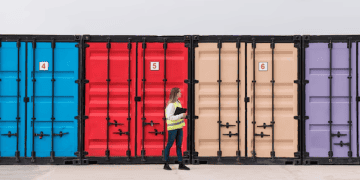The global food supply chain has seen a 79% increase in thefts over the past year, prompting businesses to enhance security measures and adopt new technologies to safeguard shipments and maintain supply stability.
In 2024, nearly £600 million worth of cargo shipments were targeted by criminals using advanced tracking methods to intercept goods at ports, rail yards, and airports. In response, companies are investing in stronger security systems and risk management strategies to protect shipments and minimize disruptions.
Security experts note that challenges such as climate-related disruptions, inflation, and evolving cyber threats have contributed to increased supply chain risks. While thefts have risen across multiple industries, food, beverages, and agricultural products remain the most targeted. Recent research shows that food and beverage thefts grew by 79% year-over-year, while agricultural thefts increased by 73%, accounting for nearly half of all in-transit hijackings.
To counteract these threats, businesses are implementing advanced monitoring systems, artificial intelligence (AI)-powered tracking, and digital verification tools to prevent fraud and enhance supply chain visibility. Logistics providers are also working closely with law enforcement and industry organizations to strengthen security protocols.
According to analysis by the British Standards Institution (BSI), food and beverage products represented 22% of all stolen goods, with one in three hijackings involving these items. Agricultural products accounted for 10% of total thefts, while electronics made up 9%. High-profile incidents include the theft of $2.5 million worth of premium olive oil in the U.S. and 1,000 tons of soybeans in Argentina.
Hijacking remains the most common method of cargo theft, making up nearly a quarter of all incidents, with 52% occurring in South America. Other high-risk regions include North America and Africa. In the UK, businesses are adapting to more sophisticated criminal tactics, including digital deception, by strengthening cybersecurity measures and adopting real-time tracking technologies.
Overall, 41% of global supply chain thefts happened in transit, 21% at warehouses, and 8% from parking lots or unsecured roadside areas. While thefts from containers and trailers have declined by 7%, criminals are increasingly targeting entire vehicles to access high-value goods.
The report also highlights the importance of supply chain transparency and collaboration to prevent fraudulent activities, including staged hijackings and insider theft. Many companies are adopting blockchain technology and enhanced inventory management systems to reduce vulnerabilities and improve traceability.
Experts emphasize that while digital tools, including AI, offer new efficiencies, they also require careful security implementation. BSI Chief Executive Susan Taylor Martin stressed the need for businesses to build resilience by integrating technology, risk management, and information security. BSI President Sergio Nogueira added that a holistic approach to supply chain management—considering trade disruptions, fraud risks, and system vulnerabilities—will be key to maintaining stability in global trade.
Stay updated with supply chain logistics news on The Supply Chain Report. Free international trade tools are available at ADAMftd.com.
#SupplyChainNews #LogisticsSecurity #InnovationInTrade #CargoTheftPrevention #GlobalTrade

















